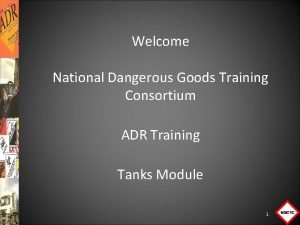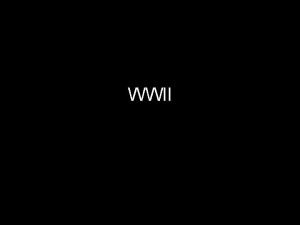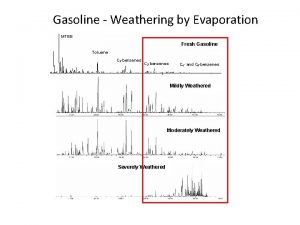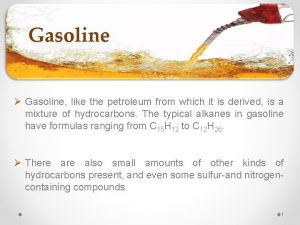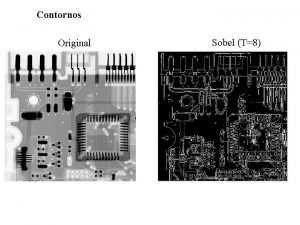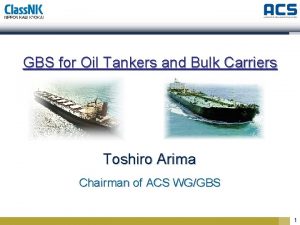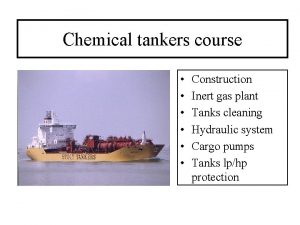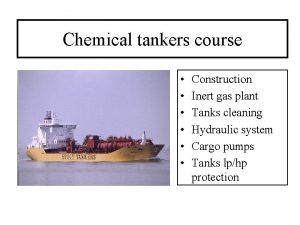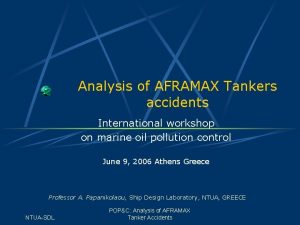GASOLINE TANKERS A Seattle Washington WWII Original Other












- Slides: 12

GASOLINE TANKERS A Seattle, Washington WWII Original Other Tanker History occurred in Seattle. Two Cimarron Class Oilers were Jumboized at Harbor Island. USS Navasota (AO-106) and USS Waccamaw AO-109 were cut in two and lengthened by 111 ft. in 1964. Then USS Seattle AOE-3 was built in Bremerton, WA in 1965 along with USS Sacramento AOE-1; USS Camden AOE-2 and USS Detroit AOE-4. This report also includes a Submarine Tanker

A TOTAL OF 82 SHIPS WERE BUILTS AS Patapsco Class - February 1943 Klickitat Class - July 1945 Guyandot Class - April 1943 Rincon Class - October 1945 Mettawee Class - August 1943 Alatna Class - July 1957 One other Class was built of two ships and Six others Classes were built of 1 ship each. Photos are from Nav. Source Online

In the summer of 1941, the multitude of ships called for in the Pacific was practically non-existent. This was not more obvious than in the number of auxiliary ships. By the summer of 1941, the number of tankers in the entire U. S. fleet had risen to 29. Four of those were slated for conversion to escort aircraft carriers, leaving only 25 available to meet the Navy’s two-ocean needs. Using then-secret method of underway replenishment, where combat ships steamed close alongside a tanker while taking on fuel, those 25 tankers were not enough to support the fleet at sea, let alone the hundreds of off shore bases and thousands of aircraft the war plans envisioned. A single fighter plane in 1941 consumed aviation gasoline at a rate of 65 gallons per hour, and just one heavy bomber consumed 220 gallons per hour. One stopgap solution was to use cargo ships to transport the petroleum products in 42 gallon steel drums to island outposts, freeing up the valuable tankers to service the fleet at sea. Port facilities at these island bases were primitive at best and frequently were non-existent. Each 42 gallon drum, weighing in excess of 270 pounds, had to be manhandled out of the cargo ship’s hold and loaded onto a barge for transport to the beach. At the water’s edge the drums had to be manhandled again as they were unloaded from the barges, moved across open, sandy beaches, and loaded onto trucks for delivery to airfield and fuel depots. This method was quickly deemed to be unsatisfactory as it was obviously dangerous, time-consuming and labor-intensive. The only acceptable alternative was to deliver gasoline by tankers with the capacity to pump hundreds of thousands of gallons of gasoline directly into bulk storage tanks ashore. The Navy’s Bureau of Ships developed the concept of a specialized gasoline tanks and specifications were completed in late 1941. From Paul Gryniewicz’s book “Avgas, Mogas & Jet Fuel”

The sixth Patapsco (AOG– 1) T 1 -MT-M 1 type, was laid down 25 May 1942 by the Seattle-Tacoma Shipbuilding Co. , Seattle, Wash. ; launched 18 August 1942; sponsored by Mrs. W. S. Zane; and commissioned 4 February 1943, Lt. A. J. Church in command. Less than three weeks after commissioning, Patapsco departed San Francisco in convoy for Pearl Harbor. From there, on 27 March, she steamed southwest to New Caledonia, whence she transported gasoline and other petroleum products to ships and bases in the Solomon's and New Hebrides until November 1944. In December, after availability at Auckland, N. Z. , she returned to the Solomon's, remaining until 12 May 1945, when she departed Guadalcanal for the Western Caro lines. Based on Ulithi from 19 May until the end of the war, she shuttled POL products to the Palaus, and, once, to Saipan. After the war, she continued her Ulithi-Palau runs, then, in November, shifted her base to Guam whence she distributed fuel and light freight and carried passengers amongst the Marianas.

Forecastle and forward officers’ and crew’s quarters – 01 deck Main deck with tank access and catwalk Fantail, mess decks, galley, wardroom and officers’ quarters – 01 deck Patapsco Class Plan view Main deck aft with crew’s quarters, sick bay, CPO quarters, ship’s store, armory and other spaces

Guyandot (AOG-16) was built as Veedol II in 1930 and acquired from her owners, Tidewater Oil, in March 1943 ; converted at Brewers Drydock, Staten Island, and renamed Guyandot; and commissioned 17 April 1943, Lt. Robert R. Crockett, USNR, in command. Taking on a full load of fuel oil, she sailed for Bermuda on 1 May; from there she was taken in tow to Oran, where she arrived 26 May. From Oran she sailed to Bizerte, Tunisia, arriving there 8 June; although under frequent air attack Guyandot worked unceasingly shuttling oil through the wreck-laden channel. Sailing to Tunis on 27 June, Guyandot began fueling ships for the Sicilian invasion and, after the assault in late July, carried high octane fuel to the newly taken port of Palermo, again under heavy air attack. NO PHOTO AVAILABLE Shikellamy (AO-90) was the former merchant tanker SS Daniel Pierce, owned and operated by the Sinclair Refining Co. , New York. She was acquired by the Navy through the War Shipping Administration on 26 March 1943, on a bare-boat basis. The tanker was converted for Navy use by the Tampa Shipbuilding Co. , Tampa, Fla. and placed in commission as Shikellamy (AO-90) on 11 April 1943, Comdr. J. W. Smith in command. Shikellamy sailed for Balboa, C. Z. , and remained in drydock there from 21 June to 15 July. Her classification was also changed on 15 July from AO-90 to AOG-47. She passed back through the canal on 22 July to test her steering. Two days later, she retransited the canal and sailed directly to Sydney, Australia, arriving on 28 August.

Mettawee (AOG-17) was laid down as Clearwater (YOG-47) by Marine Maintenance Corp. (later named the East Coast Shipyard, Inc. ), Bayonne, N. J. , 13 August 1942; launched 28 November 1942; sponsored by Mrs. Charles B. Edison; renamed and reclassified Mettawee (AOG-17) 25 March 1943; acquired by the Navy from the Maritime Commission 5 April 1943; converted by Bethlehem Steel Co. , Hoboken, N. J. ; and commissioned 26 August 1943, Lt. (jg. ) Byron R. Everson, USNR, in command. Following shakedown off Norfolk from 25 September, Mettawee sailed 21 October for New York City to join a convoy for the Canal Zone. She moored at Balboa until departing 3 December for the southwest Pacific, arriving Bora, Society Islands, the 24 th, to load supplies. Mettawee continued on to New Caledonia to debark her cargo after arrival at Noumea 11 January 1944. She departed 5 February for the New Hebrides, arriving Espiritu Santo 3 days later. From 14 February through April Mettawee served as station tanker off Funafuti Atoll, Ellice Islands.

Klickitat (AOG-64) T 1 -M-BT 1 type, was launched 24 March 1945, by St. John's River Shipbuilding Corp. , Jacksonville, Fla. , under a Maritime Commission contract; sponsored by Mrs. I. B. Mc. Daniel; acquired by the Navy and commissioned 14 July, Lt. M. J. Seibert, USCG, in command. Departing Jacksonville 28 July, Klickitat arrived Hampton Roads, Va. , 31 July. After shakedown in the Chesapeake Bay, the gasoline tanker proceeded on 23 August for Rockland, Maine, arriving the 26 th. She returned to Norfolk 3 September and departed 23 November with Michigamme (AOG-65) for Houston, Tex. Arriving 2 December, she loaded a cargo of diesel oil, sailed 3 December for the East Coast, and arrived Norfolk 12 December. Remaining at Norfolk, Klickitat decommissioned 23 January 1946 and was returned to the Maritime Commission 24 January. Her name was struck from the Navy List 7 February 1946. Following merchant service as SS Captain, she was acquired in 1949 by the Argentine Navy and renamed Punta Loyola.

Rincon (T-AOG-77), built under Maritime Commission contract, was laid down as Tarland (MC hull 2640), 24 February 1945; launched as Rincon, 5 June 1945; sponsored by Mrs. J. L. Baker; delivered to the Maritime Commission 5 October 1945 and operated under contract until 1950; transferred to the Navy at Yokohama 1 July 1950; and assigned to the newly formed Military Sea Transportation Service, Far East. Placed In service and given the hull designation on her acquisition. Rincon immediately commenced shuttling fuel to the Japanese ports whence troops and supplies were being sent to the fighting front in Korea. In September the ship was assigned Sasebo-Pusan shuttle runs as facilities at the latter were expanded to meet the needs of U. N. forces being lifted into the embattled peninsula. Throughout the 3 years of conflict, Rincon interrupted that duty only once for runs to Saigon and Haiphong in March 1951. After the truce in July 1953, she continued her Japanese-Korean shuttle service until February 1959. Then transferred to MSTS, Pacific, she carried fuel from Pearl Harbor to Midway and bases in the Marshals until reassigned to MSTS, Far East, in May 1961. She then returned to Sasebo, whence into 1974 she has carried gasoline and other fuels to American and Allied forces in the western Pacific, particularly those in Vietnam.

Alatna (AOG-81), a gasoline tanker specially constructed for service in polar regions, was launched on 6 September 1956 at Staten Island, New York, by the Bethlehem Steel Corp. ; sponsored by Mrs. Wilma Miles; and placed in service with the Military Sea Transportation Service in July of 1957. Manned by a civil service crew, Alatna carried petroleum products from ports along the Atlantic and gulf coasts and in the Caribbean Sea to scattered American outposts in both polar regions. For more than 15 years, the tanker and her crew struggled against snow, wind, and ice to support American military bases in the Arctic and American scientists in the Antarctic. On 8 August 1972, Alatna was placed out of service and laid up with the Maritime Commission's National Defense Reserve Fleet at Suisun Bay, Calif. As of July 1986, the ship was still there, in reserve.

Submarine TANKER GUAVINA (SS-362) was launched by the Manitowoc Shipbuilding Co. , Manitowoc, Wis. , 29 August 1943; sponsored by Miss Marie Roen; and commissioned 23 December 1943, Lt. Comdr. Carl Tiedeman in command. After shakedown, GUAVINA was towed down the Mississippi, reaching New Orleans 24 January 1944. She underwent training exercises at New Orleans before reaching Pearl Harbor 5 April to prepare for her first patrol. From March 1949, GUAVINA underwent extensive overhaul and modification for conversion to a submarine oiler at Mare Island, and was even equipped with a snorkel. GUAVINA recommissioned in the active fleet as SSO-362 1 February 1950 at Mare Island. After operations along the West Coast, she sailed to Norfolk via Balboa and San Juan 24 July to 25 August. On 29 January 1951, GUAVINA reported to Key West, her new homeport. Operating out of Key West, GUAVINA cruised to the Caribbean and up the East Coast to Nova Scotia to test the concept of fueling seaplanes and other submarines, although most of her work was in the Gulf of Mexico and the Straits of Florida. After overhaul at Philadelphia 18 April to 26 July 1552, GUAVINA was redesignated AGSS-362. To aid refueling, GUAVINA gained a large, raised platform over the after torpedo room, which was soon dubbed the "flight deck. "

Guavina (AGSS-362), coming alongside Chewaucan (AOG-50), to take on AVGAS, in Suda Bay, Crete, December 1956. The unusual light pattern on Guavina's hull is caused by the sun shining through the tank deck and catwalk of Chewaucan. Note the fueling platform at the stern of Guavina. From: Nav. Source Online Guavina (AGSS-362), refueling a P 5 M Marlin flying boat off Norfolk, VA. in 1955. Prior to World War II, several submarines were fitted to refuel seaplanes. During the war, Germany and Japan used this technique with some success. After the war this technique was experimented within the US Navy. It was planned to use submarines to refuel the new jet powered P 6 M flying boats. As part of this program Guavina was converted to carry 160, 000 gallons for aviation fuel. To do this, blisters were added to her sides and two stern torpedo tubes were removed. When the P 6 M project was canceled, there was no further need for submarine tankers. This concept was never used operationally in the US Navy.
 Im-102 intermodal tank
Im-102 intermodal tank National dangerous goods training consortium
National dangerous goods training consortium On a wet barrel hydrant where is the valve located
On a wet barrel hydrant where is the valve located Wwii effects
Wwii effects German map 1938
German map 1938 Wwii picture
Wwii picture 1950s television history
1950s television history Wwii phonetic alphabet
Wwii phonetic alphabet Could wwii have been prevented
Could wwii have been prevented Wwii
Wwii Wwii picture
Wwii picture 1500 dead in hawaii congress votes war
1500 dead in hawaii congress votes war Advances in technology during wwii
Advances in technology during wwii

